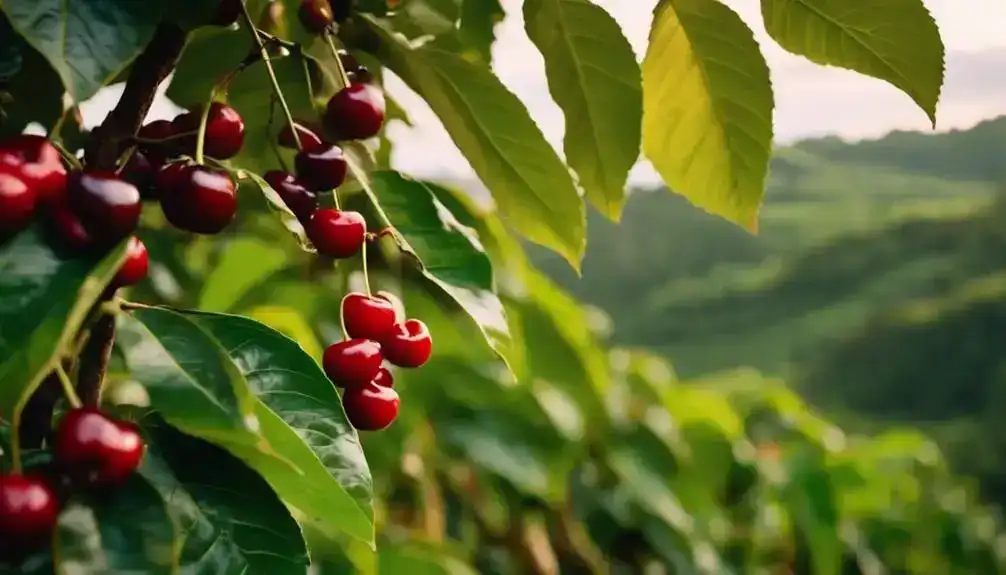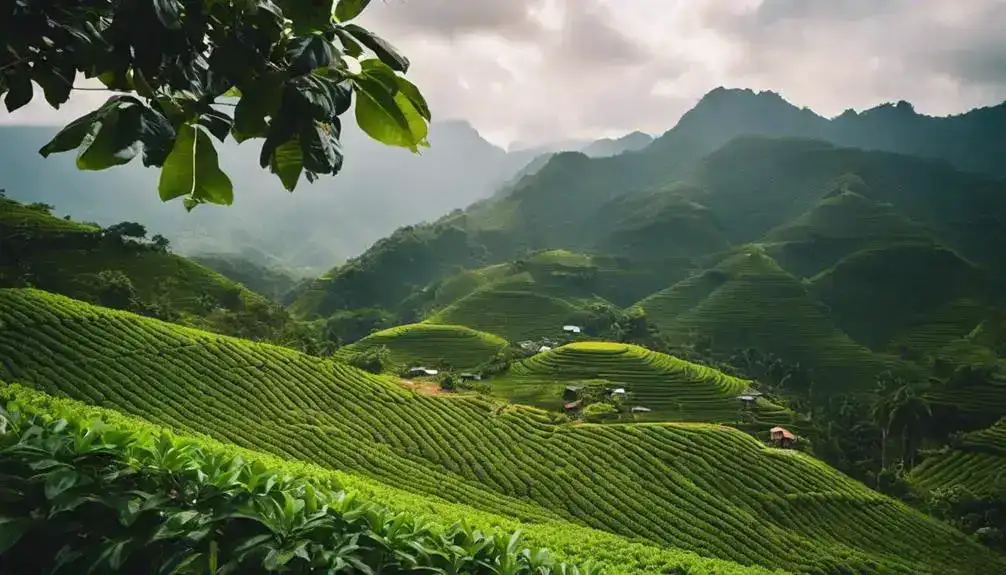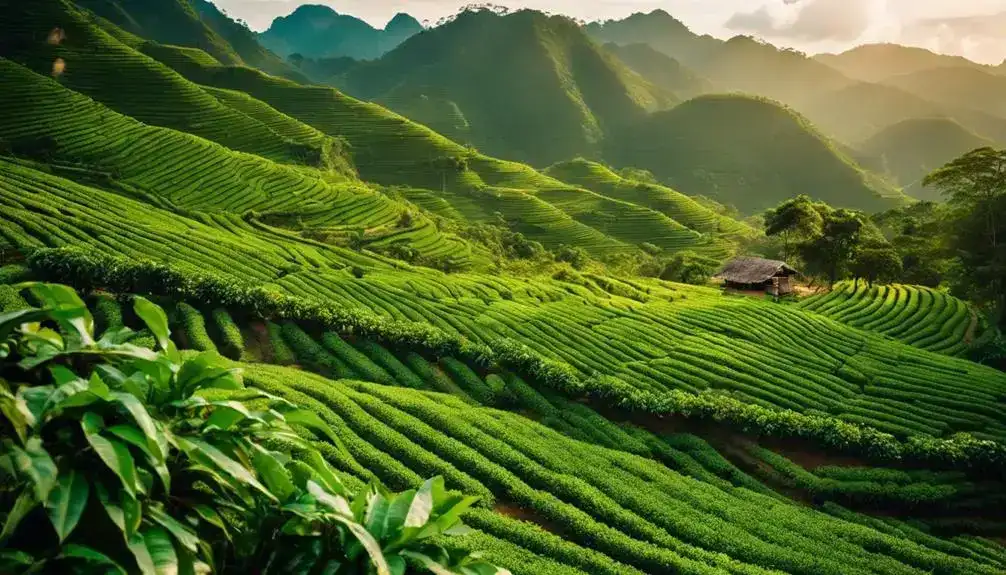Robusta coffee grows prominently in Vietnam, Brazil, and Uganda. Vietnam leads global production, showcasing bold flavors.
Brazil’s mechanized methods enhance efficiency, focusing on Espirito Santo.
Uganda plays an essential role in East Africa’s coffee industry.
Robusta thrives in hot, humid climates, needing good drainage. Understanding soil pH, altitude, and climate impacts quality.
Future trends hint at robusta market expansion and sustainability practices. Further insights await on regional characteristics, economic impact, and climate challenges for robusta coffee cultivation.
As a seasoned agronomist specializing in coffee cultivation and with extensive experience working in robusta coffee growing regions, I bring a wealth of knowledge to this discussion.
Major Robusta Coffee Growing Regions

Africa, Asia, and South America are the major regions where Robusta coffee is grown.
In Africa, countries like Uganda, the Democratic Republic of Congo, and Cameroon are notable producers.
Asia’s key players include Vietnam, India, and Indonesia, while South America boasts significant production in Brazil.
Africa
In Africa, major robusta coffee growing regions include Central Africa, East Africa, and West Africa.
Notable producers in Central Africa are the Democratic Republic of Congo and Cameroon.
Uganda leads production in East Africa, known for its high-quality robusta, while Ivory Coast and Guinea contribute to regional production in West Africa.
Central Africa
Central Africa boasts notable Robusta coffee producers, including the Democratic Republic of Congo and Cameroon.
- Rich Central African coffee beans offer unique flavors like earthy and nutty notes.
- The lush landscapes of the Democratic Republic of Congo provide ideal growing conditions.
- Cameroon’s Robusta coffee is known for its bold and full-bodied taste.
East Africa
You’ll find Uganda to be a prominent producer of high-quality Robusta coffee in the East African region.
- Coffee Varietal: Uganda’s Robusta coffee is known for its bold flavor and rich aroma.
- Roasting Techniques: The beans are often medium to dark roasted to enhance their intense flavor profile.
- Cultural Significance: Coffee plays an essential role in Ugandan society, with traditional coffee ceremonies being a common practice.
West Africa
West Africa boasts notable Robusta coffee producers such as Ivory Coast and Guinea making a substantial contribution to the regional production.
- Robusta Cultivation:
Ivory Coast and Guinea have ideal conditions for robusta coffee growth.
- Agricultural Practices:
Farmers in these regions often use traditional farming methods for cultivating robusta coffee.
- Economic Impact:
Robusta coffee plays a significant role in the economies of Ivory Coast and Guinea.
Asia
In Asia, Vietnam stands out as the world’s largest producer of Robusta coffee. Key regions like Central Highlands, Lam Dong, and Dak Lak drive production.
India also plays a significant role in Robusta cultivation. States such as Karnataka, Kerala, and Tamil Nadu contribute to the industry.
Indonesia is another major player in Robusta coffee production. Regions like Sumatra, Java, and Sulawesi are known for their robust coffee production.
Vietnam
Vietnam stands as the world’s largest producer of Robusta coffee, particularly renowned for its cultivation in key regions like Central Highlands, Lam Dong, and Dak Lak.
- Vietnamese coffee culture celebrated in vibrant coffee shops.
- Robusta bean varieties thrive in Vietnam’s tropical climate.
- Central Highlands offer ideal conditions for robust coffee production.
India
India stands as a significant producer of Robusta coffee in key regions like Karnataka, Kerala, and Tamil Nadu.
- Rich Coffee Culture: Embrace the vibrant traditions and rituals surrounding coffee consumption.
- Unique Brewing Techniques: Discover the diverse methods used to extract the perfect cup of Robusta.
- Scenic Plantations: Explore lush landscapes where Robusta coffee thrives, offering a visual treat for coffee enthusiasts.
Indonesia
Explore Indonesia’s robusta coffee growing regions, known for their unique cultivation techniques and rich coffee heritage.
- Sumatra: Home to earthy and full-bodied Robusta beans.
- Java: Produces Robusta beans with a unique smoky flavor.
- Sulawesi: Known for Robusta beans with hints of spice and a smooth finish.
Immerse yourself in Indonesian coffee culture and savor the diverse Robusta bean varieties grown in these regions.
South America
In South America, Brazil stands out as a notable producer of Robusta coffee, especially in the state of Espirito Santo.
The country’s coffee growing methods often involve mechanized harvesting to enhance yield and efficiency.
Brazil’s robusta production makes a substantial contribution to the global coffee market.
Brazil
Brazil, a significant contributor to the production of Robusta coffee in South America, is known for its mechanized harvesting techniques and focus on high yield and efficiency.
Brazilian coffee culture reflects a deep-rooted tradition of coffee consumption.
Local coffee traditions include the popular ‘cafezinho‘, a strong and sweet espresso-like coffee.
The state of Espirito Santo stands out as a key region for Robusta cultivation in Brazil.
Regional Characteristics and Production Techniques

In Africa, Robusta coffee is often intercropped with food crops to promote diversified farming practices and enhance sustainability.
In Asia, countries like Vietnam employ intensive farming methods with high fertilizer and pesticide use, while India focuses on shade-grown cultivation often intercropped with spices.
South America, particularly Brazil, utilizes mechanized harvesting techniques to guarantee high yield and efficiency in Robusta coffee production.
Africa
In Africa, Robusta coffee is often grown using intercropping practices, where it’s planted alongside food crops to promote diversified farming techniques.
When it comes to harvesting, the beans are typically handpicked to guarantee quality control and maintain the desired flavor profile.
These methods highlight the importance of traditional farming practices in the region’s coffee production.
Growing Practices
Central Africa and East Africa are known for their diverse growing practices of Robusta coffee, often incorporating intercropping with food crops for a sustainable farming approach.
Intercropping with food crops maintains soil health.
Pest management techniques secure crop protection.
Crop rotation enhances soil fertility for robust coffee growth.
Harvesting Methods
Harvesting methods for Robusta coffee in Africa typically involve handpicking to guarantee quality control.
- Harvesters meticulously select ripe cherries.
- Each cherry is delicately plucked from the tree.
- Handpicked beans undergo thorough sorting for best flavor.
These traditional methods secure top-notch quality and support sustainability practices in the region.
Asia
In Asia, Vietnam stands out as the world’s largest producer of Robusta coffee, with key regions including the Central Highlands, Lam Dong, and Dak Lak.
India’s coffee growing practices involve shade-grown cultivation in states like Karnataka, Kerala, and Tamil Nadu.
Indonesia utilizes a mix of traditional and modern techniques, with a significant focus on the wet-hulling process in regions like Sumatra, Java, and Sulawesi.
Vietnam’s Coffee Cultivation
Vietnam leads the world in Robusta coffee production with key regions located in Central Highlands, Lam Dong, and Dak Lak.
- Intensive farming techniques guarantee high yields.
- Fertilizers and pesticides are commonly used.
- Emphasis on productivity drives cultivation methods.
Indian Coffee Growing Practices
Moving our focus from Vietnam’s coffee cultivation, let’s explore the unique coffee growing practices in India.
- Shade Cultivation: Coffee plants in India are often grown under the shade of taller trees, providing a natural canopy that protects the delicate coffee cherries from harsh sunlight.
- Sustainable Practices: Indian coffee farmers prioritize sustainable farming techniques, focusing on preserving the ecosystem and maintaining soil health.
- Intercropping with Spices: Indian coffee plantations often integrate spice crops alongside coffee plants, promoting biodiversity and enhancing the flavors of both crops.
Indonesian Techniques
Utilizing a combination of traditional and modern methods, Indonesian coffee producers employ significant techniques in the cultivation and processing of Robusta coffee.
Traditional techniques blended with modern innovations enhance flavor profiles.
The wet-hulling process, a unique Indonesian method, adds distinct characteristics.
Sustainable farming practices are increasingly integrated for long-term environmental benefits.
South America
In South America, Brazil stands out as a significant producer of Robusta coffee, with a primary focus on high yield and efficiency in their growing methods.
Brazilian coffee cultivation often involves mechanized harvesting techniques to enhance productivity.
The country’s coffee industry places a strong emphasis on maximizing output while maintaining quality standards.
Brazilian Coffee Growing Methods
Brazil’s coffee growing methods involve mechanized harvesting techniques with a focus on achieving high yield and operational efficiency.
- Large-scale farms utilize advanced machinery for harvesting.
- Precision irrigation systems guarantee water conservation.
- Sustainable practices like composting and crop rotation are integrated.
Climatic and Soil Conditions for Robusta Coffee

Robusta coffee thrives in hot, humid climates with an ideal temperature range of 20-30°C. It requires annual rainfall between 1200-2500 mm and prefers well-drained, fertile soils with slightly acidic to neutral pH levels (5.5-6.5). The coffee plant is typically grown at altitudes ranging from 200-800 meters above sea level. Understanding these climatic and soil conditions is essential for successful Robusta coffee cultivation.
Climate Requirements
Amidst the lush landscapes where Robusta coffee thrives, the ideal temperature range for cultivation typically falls between 20 to 30 degrees Celsius.
To guarantee your Robusta coffee plants flourish, consider the following climate requirements:
- Hot and Humid Climates: Robusta coffee grows best in regions with hot and humid weather conditions, providing the necessary warmth and moisture for excellent growth.
- Ideal Temperature Range: The temperature sweet spot for robusta coffee cultivation lies between 20 to 30 degrees Celsius, offering the perfect balance for robust plant development.
- Annual Rainfall: Robusta coffee requires a significant amount of annual rainfall ranging from 1200 to 2500 mm, essential for ensuring adequate soil moisture levels for robust growth.
Understanding these climate adaptation and growing conditions is essential for cultivating healthy and productive Robusta coffee plants.
Soil Preferences
To guarantee the best growth of Robusta coffee plants, understanding the soil preferences is key in cultivating a successful plantation.
Here are three essential factors to keep in mind:
- Key pH: Robusta coffee thrives in soils with slightly acidic to neutral pH levels ranging from 5.5 to 6.5. Maintaining this pH range is essential for the plant to absorb nutrients effectively and flourish.
- Nutrient Requirements: Fertile soils are preferred by Robusta coffee plants as they require adequate nutrients for healthy growth. Ensuring the soil is rich in essential elements like nitrogen, phosphorus, and potassium is crucial for robust plant development and high-quality bean production.
- Drainage: Robusta coffee prefers well-drained soils to prevent waterlogging, which can lead to root rot and other detrimental issues. Good drainage facilitates oxygen uptake by the roots and helps maintain the plant’s overall health and productivity.
Altitude Considerations
When cultivating Robusta coffee, considering altitude is essential for the best growth and development of the plants. Altitude effects cultivation practices and has a significant impact on coffee quality.
Here are three key points to keep in mind:
- Higher Altitudes: Growing Robusta coffee at higher altitudes, typically between 600-800 meters above sea level, can result in a slower maturation process for the beans. This extended growing period often enhances the flavor profile of the coffee, leading to a more complex and nuanced taste.
- Lower Altitudes: Robusta coffee grown at lower altitudes, around 200-400 meters above sea level, tends to have a faster maturation rate. This can result in beans with a more straightforward flavor profile, often characterized by a bold and intense taste with higher caffeine content.
- Optimal Altitude Range: While Robusta can thrive at various altitudes, the ideal range for cultivating high-quality beans is typically between 400-600 meters above sea level. This altitude provides a balanced environment for the plants, allowing them to develop the desired flavor attributes while maintaining a healthy growth rate.
Economic and Environmental Impact

Robusta coffee cultivation plays a pivotal role in the economies of producing countries, providing essential income and employment opportunities.
However, this growth has resulted in environmental challenges, including deforestation, habitat loss, and water pollution from agrochemicals.
To address these issues, there’s a growing focus on implementing sustainable farming practices and certifications to promote environmentally friendly methods within the industry.
Economic Contributions
Playing an essential role in the economies of their respective countries, Robusta coffee is indispensable for providing income and employment opportunities. This flavorful coffee variety contributes immensely to trade relationships, acting as an important export commodity for countries like Vietnam, Brazil, and Uganda. Below is a table highlighting the economic contributions of Robusta coffee in these dominant producing nations:
| Country | Income Generation | Employment Opportunities |
|---|---|---|
| Vietnam | Major export revenue from Robusta coffee | Provides jobs in cultivation and processing |
| Brazil | Significant economic impact from Robusta production | Employment in coffee farms and processing facilities |
| Uganda | Robusta coffee is a key export product | Creates job opportunities in the coffee industry |
| India | Emerging player in Robusta production | Coffee cultivation supports rural employment |
These countries rely on Robusta coffee not only for economic stability but also for sustaining livelihoods through employment in various stages of the coffee supply chain.
Environmental Challenges
The expansion of coffee plantations poses significant environmental challenges for Robusta coffee production regions.
- Water conservation:
Large-scale cultivation of Robusta coffee requires substantial amounts of water for irrigation, leading to increased pressure on local water sources and potential water scarcity in regions where water resources are already limited.
- Pesticide management:
Intensive farming practices, especially in countries like Vietnam, often involve the heavy use of pesticides to control pests and diseases. Improper pesticide application can result in contamination of soil and water sources, impacting biodiversity and human health.
- Habitat loss:
Clearing land for coffee plantations contributes to deforestation, disrupting natural habitats and leading to loss of biodiversity. This encroachment on forests not only affects wildlife but also disrupts crucial ecosystems that support local communities.
Balancing the economic benefits of Robusta coffee cultivation with sustainable practices like water conservation and pesticide management is essential to mitigate these environmental challenges and secure the long-term viability of coffee production regions.
Sustainability Practices
Sustainable farming practices are increasingly gaining importance in the coffee industry. When it comes to Robusta coffee production, promoting sustainability and eco-friendly practices is essential for the economic and environmental impact.
Here are three key aspects to ponder:
- Organic Farming: Shifting to organic farming methods reduces the use of synthetic pesticides and fertilizers, promoting soil health and biodiversity.
- Water Conservation: Implementing water-efficient irrigation systems and practices helps in reducing water usage and minimizing pollution from agrochemical runoffs.
- Community Empowerment: Supporting fair trade and Rainforest Alliance certifications ensures that farmers receive fair wages, work under safe conditions, and protect the surrounding ecosystems.
Future Prospects and Trends

Future prospects and trends in the Robusta coffee industry include a growing demand for Robusta in instant coffee and espresso blends, as well as expansion into new markets and regions.
Research into improving yield and quality presents future growth opportunities, with potential for increased cultivation in non-traditional regions.
Climate change poses challenges, leading to shifts in suitable growing regions and efforts to develop more resilient coffee varieties.
Market Trends
With a growing demand for Robusta in instant coffee and espresso blends, market trends are indicating a promising future for this coffee variety.
Consumer Preferences: Consumers are increasingly favoring the strong flavor and high caffeine content of Robusta in their instant coffee and espresso drinks. This preference is driving the market towards more Robusta inclusion in various blends.
Market Expansion: The market for Robusta coffee is expanding into new regions and markets, catering to a broader audience looking for a robust coffee experience. This expansion is opening up opportunities for both traditional and emerging coffee-growing regions to participate in the lucrative Robusta market.
Quality Enhancement: With the focus on improving the quality and yield of Robusta coffee, advancements in cultivation techniques and processing methods are being explored. This emphasis on quality enhancement aligns with the growing consumer demand for premium Robusta coffee products.
Future Growth Opportunities
To explore future growth opportunities for Robusta coffee, consider researching advancements in cultivation techniques and processing methods.
Here are three key areas to focus on:
- Genetic Resilience:
Investigate the development of robusta coffee varieties that exhibit increased resilience to pests, diseases, and changing environmental conditions. Genetic research plays an essential role in creating more durable plants that can thrive in various climates, ensuring a stable and sustainable supply of high-quality coffee beans.
- Market Expansion:
Explore opportunities for expanding the market reach of Robusta coffee beyond traditional regions. Identify emerging consumer trends and preferences to tailor production and marketing strategies accordingly. By tapping into new markets and consumer segments, the demand for Robusta coffee can be further stimulated, leading to increased profitability for growers and stakeholders.
- Innovative Processing Methods:
Stay updated on innovative processing techniques that enhance the flavor profile and quality of Robusta coffee. Advancements in processing technologies can improve the overall sensory experience of the final product, making it more appealing to a wider range of consumers and driving growth in the industry.
Impact of Climate Change on Robusta Coffee
Exploring the impact of climate change on Robusta coffee reveals significant challenges and opportunities for the industry’s future sustainability and growth. As the climate continues to shift, here are three key points to take into account:
- Essential varieties: Developing coffee plants that can withstand changing environmental conditions is pivotal for the industry’s longevity. Research and breeding programs are focusing on creating robust Robusta coffee varieties resilient to temperature fluctuations and erratic rainfall patterns.
- Adaptation strategies: Implementing adaptive practices is imperative to mitigate the effects of climate change on Robusta coffee production. Farmers are exploring new cultivation techniques, adjusting irrigation methods, and enhancing soil management to secure the continued growth of coffee crops in the face of environmental challenges.
- Crucial practices for environmental resilience: Embracing sustainable farming methods is essential to enhance the resilience of Robusta coffee plants and protect the surrounding ecosystems. Practices such as agroforestry, organic farming, and water conservation not only benefit the environment but also contribute to the long-term viability of coffee production.
Conclusion
As you explore the dominant countries shaping the global presence of robusta coffee, consider this: Vietnam is the largest producer of robusta coffee, accounting for over 40% of the world’s production.
This statistic highlights the significant role Vietnam plays in the robusta coffee industry, showcasing the country’s robust cultivation practices and economic impact on the global market.
Stay informed and continue to savor the rich flavors and diverse landscapes of robusta coffee growing regions around the world.

